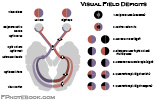II. Definitions
- Hemianopsia (Hemianopia)
- Partial or complete loss of Vision in one half of the Visual Fields of one or both eyes
IV. Physiology
- Objects in the Visual Field are projected onto each eye's Retina as a mirror image
- Upper right Visual Field localizes to the lower left Retina of each eye
- Signals from each Retina follow the Optic Nerve to the Optic Chiasm, in the region of the Pituitary Gland
- Left Visual Field signals from each Retina (left medial and right lateral) join at Optic Chiasm
- Left Visual Field signals follow the Optic Nerve to the right Lateral Geniculate Body
- Right Lateral Geniculate Body signals follow right Optic Radiations
- Upper Visual Fields through the Temporal Lobe
- Lower Visual Fields through the Parietal Lobe)
- Signals terminate in the right Occipital Lobe visual cortex (Brodmann Area 17-19)
- Right Visual Fields are similarly routed to the left Occipital Lobe
V. Types: Unilateral Field Cuts
- Peripheral Vision Loss
- Central Scotoma
- Migraine Headache
- Macular Degeneration
- Demyelinating Disease (e.g. Multiple Sclerosis)
- Monocular Blindness
VI. Types: Bilateral Field Cuts
- Bitemporal Hemianopsia (Hemianopia)
- Visual Field loss in the lateral, temporal hemifields of both eyes
- Suggests Optic Chiasm lesion
- Binasal Hemianopsia (Hemianopia)
- Visual Field loss in the medial, nasal hemifields of both eyes
- Brain Mass
- Keratoconus
- Bilateral internal carotid aneurysms
- Neurosyphilis
- Optic Neuropathy
- Quadrantanopsia (Quadrantanopia)
- Loss of Vision in one quarter of the Visual Field in one or both eyes
- Altitudinal hemianopsia refers to Visual Field loss above or below the horizontal Meridian
- Localizes lesions to the Optic Radiations between the Lateral Geniculate Body and the visual cortex (Occipital Lobe)
- Parietal lesions affect the inferior Visual Field
- Temporal lesions affect the superior Visual Field
- Homonymous Hemianopsia (Hemianopia)
- Visual Field Defect with same half of Visual Field loss from each eye (left or right Visual Field)
- Occipital lesion

